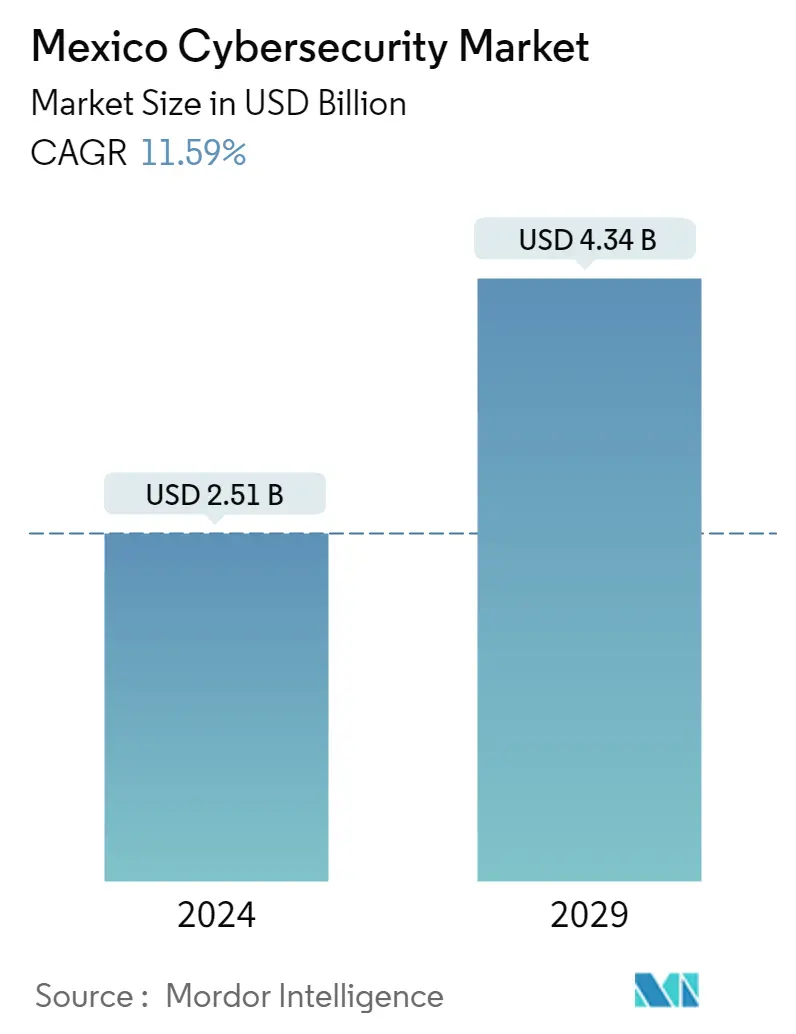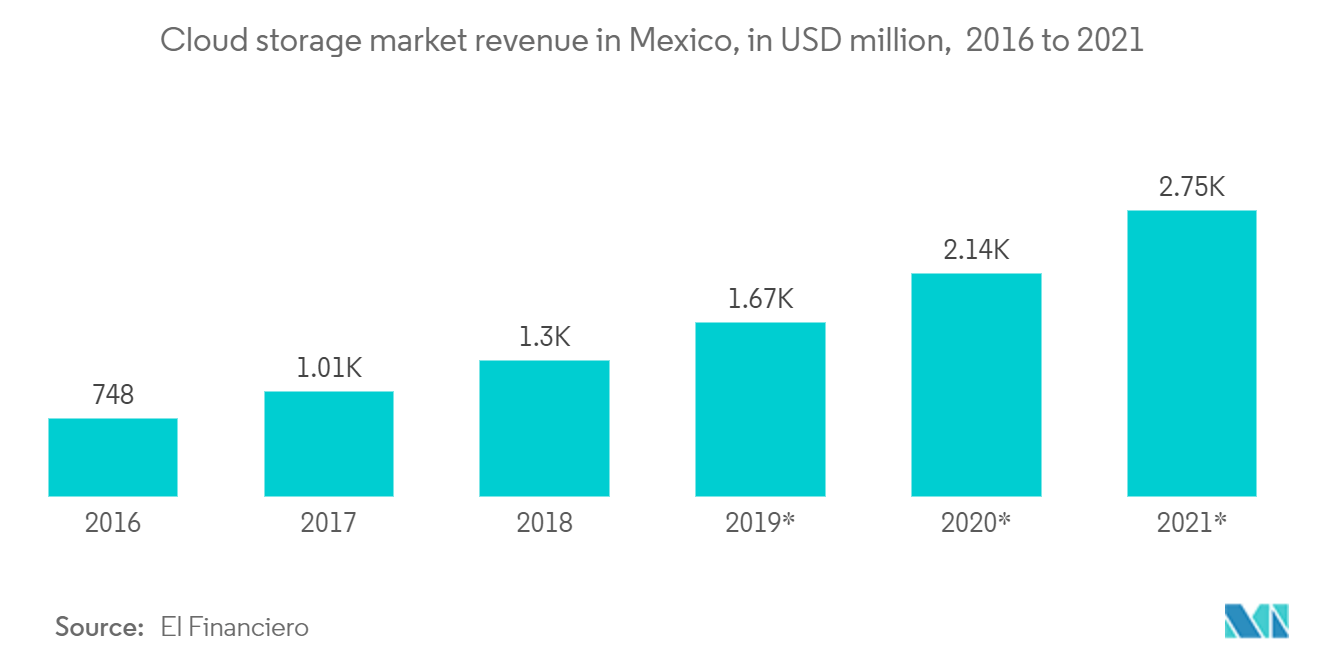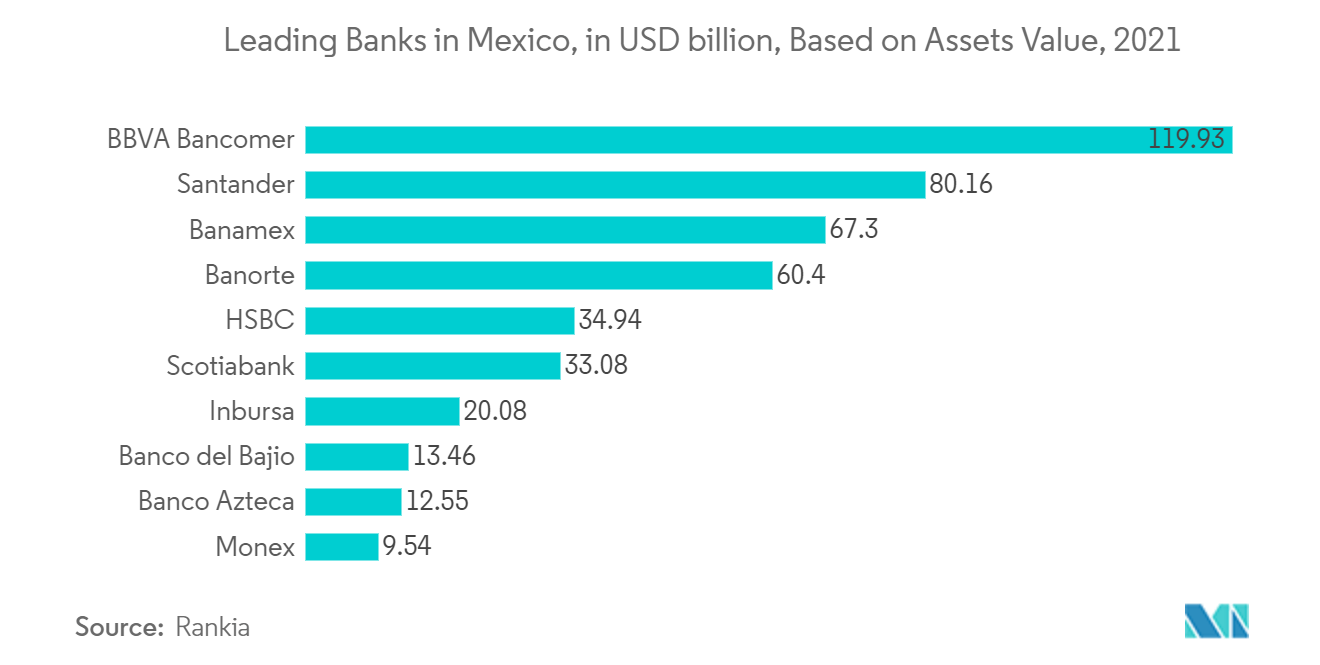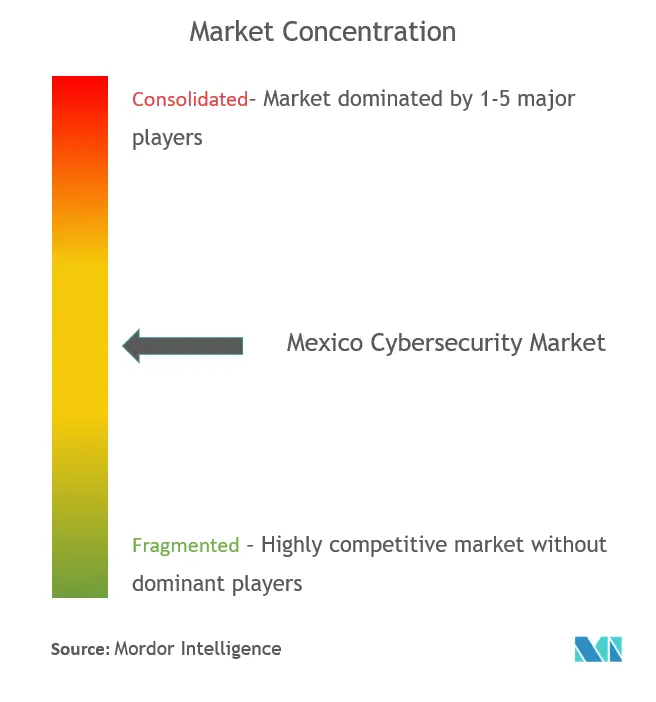Mexico Cybersecurity Market Size

| Study Period | 2019 - 2029 |
| Base Year For Estimation | 2023 |
| Market Size (2024) | USD 2.51 Billion |
| Market Size (2029) | USD 4.34 Billion |
| CAGR (2024 - 2029) | 11.59 % |
| Market Concentration | Medium |
Major Players
*Disclaimer: Major Players sorted in no particular order |
Mexico Cybersecurity Market Analysis
The Mexico Cybersecurity Market size is estimated at USD 2.51 billion in 2024, and is expected to reach USD 4.34 billion by 2029, growing at a CAGR of 11.59% during the forecast period (2024-2029).
Cyberattacks on public and private establishments in Mexico are expected to increase exponentially throughout the forecast period. Mexico, however, has no national cybersecurity plan, encouraging the private sector to independently introduce self-regulatory schemes to try and protect itself against cyberattacks.
- Mexico is also witnessing rapid urbanization and internet penetration, further fueling the cybersecurity market. Brazil, Argentina, and Mexico have already established Cyber Emergency Response Teams and Computer Security Incident Response Teams to combat cyber-attacks, resulting in a surge in demand over the forecast period.
- At a global level, Mexico's market demand is high, and there are some large international companies. However, there are also domestic companies that are benefiting from the growth of the industry. There is a clear requirement for increased product offerings (especially for SMEs) and more competition within the sector. A dedicated IT cluster could be a solution for developing low-cost cybersecurity products and services.
- Mexico ranks 52 out of 182 countries in terms of vulnerability to cyberattacks, according to the International Telecommunications Union (ITU). Moreover, the country has been witnessing numerous attacks. Crypto-jacking is one of the leading cybersecurity issues the country's businesses face. Mexico is immature in cybersecurity due to a lack of investment in cybercrime protection.
- COVID-19 has boosted the market in the country. For instance, according to a study by National Cyber Security Organizations, the revenue generated from cyber solutions in the country increased to EUR 56 billion in 2021 from EUR 0.45 billion in 2020. The same study also forecasts that the revenue will cross EUR 1.48 billion by the end of 2027.
Mexico Cybersecurity Market Trends
This section covers the major market trends shaping the Mexico Cybersecurity Market according to our research experts:
Cloud Deployment is Expected to Drive the Market
- Cloud is one of the most rapidly growing recent technologies, eliminating the traditional boundaries of IT, creating new markets, spurring the mobility trend, and enabling advances in unified communications.
- Cybercriminals targeting remote employees to steal critical data have recently increased the demand for cybersecurity in the country. According to the Inter-American Development Bank (IDB), the situation is much more volatile in Latin America, where most countries like Mexico do not have a strong cyberinfrastructure to withstand attacks.
- Installation prices are an integral part of the deployment. Most Mexican companies are shifting to cloud-based cybersecurity services as it is seen as a flexible and economical alternative.
- Moreover, Mexico is one of the major IaaS markets in the Latin American Region. The government has also announced plans to improve the nation's digital infrastructure with cloud connectivity.

BFSI Segment is Expected to Hold a Significant Market Share
- The BFSI industry is one of the vulnerable infrastructure segments facing numerous data breaches and cyberattacks. This is due to the sector's large customer base and financial information at stake. For instance, in 2021, malware called Ploutus targeted ATMs of prominent banks in Mexico.
- In the past, the Bank of Mexico (Banco de México), along with other banks and insurance companies, have been attacked. The major insurance regulator, the Insurance and Bonding National Commission (Comisión Nacional de Seguros y Fianzas) (CNSF), was also targeted. Demand for cyber security insurance will continue to grow, as no sector is immune to cyberattacks and the responsibilities that arise from them (which are exacerbated by privacy laws and financial secrecy).
- At a global level, the demand in the Mexican market is high, and there are some large international companies. However, there are also domestic companies that are benefiting from the growth of the industry. There is a clear requirement for increased product offerings (especially for SMEs) and more competition within the sector. A dedicated IT cluster could be a solution for developing low-cost cybersecurity products and services.
- Cybercriminals are optimizing various diabolical cyberattacks to immobilize the financial sector as a highly lucrative operation model with returns and the added upside of relatively low risk and detectability. These attacks' threat landscape ranges from Trojans, ATM, ransomware, mobile banking malware, data breaches, institutional invasion, data thefts, fiscal breaches, etc.
- Amid the rising cyber attacks, the country has set up various bodies to protect citizens' data. For instance, Information and Protection of Personal Data protect the personal information of Mexican citizens. According to a study by Wilson Center, Mexico's digital infrastructure has reached around half of the population, the vulnerabilities are prevalent, and the country's administration has been required to adapt to the era of smart grids, telecommunications, and online finance.

Mexico Cybersecurity Industry Overview
The Mexico cybersecurity market is moderately fragmented. Players in the market adopt strategic initiatives such as mergers and acquisitions, partnerships, and new product offerings due to increasing awareness regarding mobility security among enterprises.
- May 2021: Tec de Monterrey and Microsoft signed a partnership agreement to promote the development of technologies and capabilities for access controls, incident responses, sharing intelligence information, detecting new forms of attacks, and forensic computing. This will take place at Tec's Cybersecurity Hub to make these technologies more accessible, secure, and reliable against online risks.
- September 2021: Tata Consultancy Services (TCS) began the construction of a cyber security center in Queretaro, Mexico. This facility is aimed to serve clients throughout Latin America.
Mexico Cybersecurity Market Leaders
-
Framework Security
-
Inflection Point
-
Scitum
-
MCM Telecom
-
ARAME
*Disclaimer: Major Players sorted in no particular order

Mexico Cybersecurity Market News
- October 2021 - Telefónica Tech and CyberArk teamed up to deliver an expanded portfolio of SaaS-based cybersecurity solutions that prioritize a security-first approach to protecting against identity-driven risk. Additionally, the customers will benefit from being able to secure access for all human and machine identities without sacrificing business agility. The services are offered in Latin American countries like Mexico, Peru, Brazil, etc.
- May 2022: GigNet Mexico, a digital infrastructure company that provides regional fiber optic broadband networks, launched several new products to help protect hospitality and corporate customers from financial loss through cybercrime, ransomware, and other malicious attacks. With the average cost of cyberattacks to businesses potentially reaching millions of dollars, GigNet's new cybersecurity products are touted as tools for cyber risk prevention, planning, and early detection.
Mexico Cybersecurity Market Report - Table of Contents
1. INTRODUCTION
- 1.1 Study Deliverables
- 1.2 Study Assumptions
- 1.3 Scope of the Study
2. RESEARCH METHODOLOGY
3. EXECUTIVE SUMMARY
4. MARKET INSIGHTS
- 4.1 Market Overview
-
4.2 Industry Attractiveness - Porter's Five Forces Analysis
- 4.2.1 Bargaining Power of Suppliers
- 4.2.2 Bargaining Power of Consumers
- 4.2.3 Threat of New Entrants
- 4.2.4 Intensity of Competitive Rivalry
- 4.2.5 Threat of Substitutes
- 4.3 Industry Guidelines and Policies
- 4.4 Assessment of Impact of COVID-19 on the Industry
5. MARKET DYNAMICS
-
5.1 Market Drivers
- 5.1.1 Rapidly Increasing Cybersecurity Incidents and Regulations Requiring Their Reporting
- 5.1.2 Growing M2M/IoT Connections Demanding Strengthened Cybersecurity in Enterprises
-
5.2 Market Challenges
- 5.2.1 Lack of Supporting Infrastructure
- 5.2.2 Lack of Cybersecurity Professionals
6. MARKET SEGMENTATION
-
6.1 By Product Type
- 6.1.1 Solutions
- 6.1.1.1 Application Security
- 6.1.1.2 Cloud Security
- 6.1.1.3 Consumer Security Software
- 6.1.1.4 Data Security
- 6.1.1.5 Identity Access Management
- 6.1.1.6 Infrastructure Protection
- 6.1.1.7 Integrated Risk Management
- 6.1.1.8 Network Security Equipment
- 6.1.1.9 Other Solution Types
- 6.1.2 Services
- 6.1.2.1 Professional
- 6.1.2.2 Managed
-
6.2 By Deployment
- 6.2.1 On-premise
- 6.2.2 Cloud
-
6.3 By End-user Industry
- 6.3.1 BFSI
- 6.3.2 Healthcare
- 6.3.3 Aerospace and Defense
- 6.3.4 IT and Telecommunication
- 6.3.5 Government
- 6.3.6 Retail
- 6.3.7 Manufacturing
- 6.3.8 Other End-user Industries
7. COMPETITIVE LANDSCAPE
-
7.1 Company Profiles
- 7.1.1 Framework Security
- 7.1.2 Inflection Point
- 7.1.3 Scitum
- 7.1.4 MCM Telecom
- 7.1.5 ARAME
- 7.1.6 CYCSAS
- 7.1.7 KIO Cyber
- 7.1.8 BMobile Grupo Scanda
- 7.1.9 Delta Protect
- 7.1.10 Sictel Solutions
- *List Not Exhaustive
8. INVESTMENT ANALYSIS
9. MARKET OPPORTUNITIES AND FUTURE TRENDs
** Subject To AvailablityMexico Cybersecurity Industry Segmentation
IT advancement, communication technologies, and smart energy grids are changing the landscapes of almost every country's critical infrastructure and business networks. However, with rapidly changing technology comes rapidly advancing threats. Cybersecurity solutions help an organization to monitor, detect, report, and counter cyber threats, which are internet-based attempts to damage or disrupt information systems and hack critical information, using spyware and malware and by phishing, to maintain data confidentiality. The market sizing for the study has been provided based on the end-user spending on Cybersecurity solutions and services.
| By Product Type | Solutions | Application Security |
| Cloud Security | ||
| Consumer Security Software | ||
| Data Security | ||
| Identity Access Management | ||
| Infrastructure Protection | ||
| Integrated Risk Management | ||
| Network Security Equipment | ||
| Other Solution Types | ||
| By Product Type | Services | Professional |
| Managed | ||
| By Deployment | On-premise | |
| Cloud | ||
| By End-user Industry | BFSI | |
| Healthcare | ||
| Aerospace and Defense | ||
| IT and Telecommunication | ||
| Government | ||
| Retail | ||
| Manufacturing | ||
| Other End-user Industries |
Mexico Cybersecurity Market Research FAQs
How big is the Mexico Cybersecurity Market?
The Mexico Cybersecurity Market size is expected to reach USD 2.51 billion in 2024 and grow at a CAGR of 11.59% to reach USD 4.34 billion by 2029.
What is the current Mexico Cybersecurity Market size?
In 2024, the Mexico Cybersecurity Market size is expected to reach USD 2.51 billion.
Who are the key players in Mexico Cybersecurity Market?
Framework Security , Inflection Point, Scitum, MCM Telecom and ARAME are the major companies operating in the Mexico Cybersecurity Market.
What years does this Mexico Cybersecurity Market cover, and what was the market size in 2023?
In 2023, the Mexico Cybersecurity Market size was estimated at USD 2.25 billion. The report covers the Mexico Cybersecurity Market historical market size for years: 2019, 2020, 2021, 2022 and 2023. The report also forecasts the Mexico Cybersecurity Market size for years: 2024, 2025, 2026, 2027, 2028 and 2029.
Mexico Cyber Security Industry Report
Statistics for the 2024 Mexico Cyber Security market share, size and revenue growth rate, created by Mordor Intelligence™ Industry Reports. Mexico Cyber Security analysis includes a market forecast outlook to 2029 and historical overview. Get a sample of this industry analysis as a free report PDF download.



